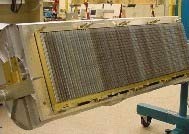Radar as Death Ray?

According to Aviation Week, the Pentagon is now developing active electronically scanned array (AESA) radars that could be used as weapons.
A bizarre historical twist to this story is that in 1934, a rumor was started to the effect that Nazi Germany had developed a death ray based on radar. Physicist Robert Watson-Watt was asked to check on the feasibility of such a weapon. He quickly determined that it was unlikely, but that using radio waves to locate incoming bombers might be a real possibility. By 1937, three stations were ready, with more to come; this was a key element in winning the Battle of Britain during WWII.
Some of the airborne AESA radars... use thousands of small transmitters/receivers, each a couple of inches square, that allow the array to conduct many tasks simultaneously. Those include detection of small, even stealthy targets, tracking and communications... and "jamming"... Possible AESA techniques for attacking another radar could include burning through the target radar's antenna side-lobes, filter side-lobes, or other known features of the target system. Radar specialists suggest it is reasonable to suppose this capability is already available to some fielded systems... [Airborne radar weapon development] appear[s] to be focused on cruise missiles and self-defense against anti-radiation, home-on-jam and air-to-air missiles. The radars seem particularly effective against the latter categories because energy available to focus on the approaching missile increases as an inverse square as distance decreases. (AESA radar)
While HPM produces higher peak power, AESA often generates greater average power. That produces different operational and targeting strategies. For example, Raytheon's [HPM-based] airport protection system uses infrared sensors to find the target and determine where to focus its beam. It also produces effects at longer range, possibly as much as 100 mi., because it produces powerful pulses of energy. AESA radar has the built-in ability to find and track a target, so it can be held on the target for the necessary additional microseconds needed to create its weapons effect. (AESA radar)
It was a British writer, H. G. Wells, who first suggested the idea of "death
A pulsating polarized ether wave, if directed on a metal object can be reflected in the same manner as a light ray is reflected from a bright surface? By manipulating the entire apparatus like a searchlight, waves would be sent over a large area. (Read more about Hugo Gernsback's actinoscope)
(This Science Fiction in the News story used with permission from Technovelgy.com
Get the world’s most fascinating discoveries delivered straight to your inbox.



